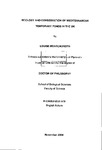ECOLOGY AND CONSERVATION OF MEDITERRANEAN TEMPORARY PONDS IN THE UK
| dc.contributor.author | MCABENDROTH, LOUISE | |
| dc.contributor.other | Faculty of Science and Engineering | en_US |
| dc.date.accessioned | 2013-09-24T10:48:34Z | |
| dc.date.available | 2013-09-24T10:48:34Z | |
| dc.date.issued | 2004 | |
| dc.identifier | NOT AVAILABLE | en_US |
| dc.identifier.uri | http://hdl.handle.net/10026.1/1922 | |
| dc.description.abstract |
Macroinvertebrate and plant assemblage composition and abiotic habitat characteristics were examined in seventy-six ponds, in the New Forest (Hampshire. UK) and on the Lizard Peninsula (Cornwall, UK), in order to unravel the ecological processes influencing ponds at a range of spatial scales and provide a clear definition of Mediterranean Temporary Pond (MTP) habitat (92/43/EEC) in the UK. In addition, a set of newly created experimental ponds were monitored on the Lizard to examine patterns of colonisation and evaluate the use of habitat creation in temporary pond conservation. The findings are synthesised into a number of management recommendations for ponds in the regions, with a particular focus on MTPs. MTPs equated to ephemeral, winter-flooded ponds occurring in shallow depressions on the Lizard, which had some floristic similarities to other western Atlantic fringe sites. They were dominated by low growing grasses, rushes and rare annual species of the Nanocyperion alliance along with a depauperate macroinvertebrate assemblage comprising Coleoptera (including characteristic rare taxa), Trichoptera and Chironomidae. The strength of physicochemical and spatial pattern in assemblage composition varied between the regions. Lizard macroinvertebrate assemblage similarity was spatially autocorrelated and related to water chemistry and pond area but New Forest macroinvertebrate similarity was not related to any of the measured physicochemical parameters. Plant assemblage composition was only weakly related to wet phase physicochemistry. Pond vegetation structured macroinvertebrate assemblages in different ways at different spatial scales. At large-scales, macrophyte richness and composition affected macroinvertebrate assemblage composition in both regions, whereas, at smaller-scales, macrophyte structural complexity (measured using fractals) influenced tx>dy size scaling and overall biomass of macroinvertebrates. Assemblages in both regions were significantly nested, indicating that species-poor sites tended to be subsets of rich sites. Macroinvertebrate nesting, on the Lizard, was not due to passive sampling, and was best explained by pond area, with habitat parameters and isolation being of secondary importance. Nested and idiosyncratic taxa differed in their spatial response to factors which structured assemblage-level nestedness; idiosyncratic taxa tended to possess broad ecological tolerance and good dispersal capacity, whilst nested species had narrower tolerance or limited powers of dispersal. Experimental pond macroinvertebrate assemblage similarity converged with pond age, despite continued variation in physicochemistry, and the assemblages that developed were not significantly different from small natural ponds in the region. Augmentation of current MTP habitat could therefore be achieved by creating new sites in close proximity to existing water bodies. | en_US |
| dc.description.sponsorship | English Nature | en_US |
| dc.language.iso | en | en_US |
| dc.publisher | University of Plymouth | en_US |
| dc.title | ECOLOGY AND CONSERVATION OF MEDITERRANEAN TEMPORARY PONDS IN THE UK | en_US |
| dc.type | Thesis | |
| plymouth.version | Full version | en_US |
| dc.identifier.doi | http://dx.doi.org/10.24382/4734 |
Files in this item
This item appears in the following Collection(s)
-
01 Research Theses Main Collection
Research Theses Main


